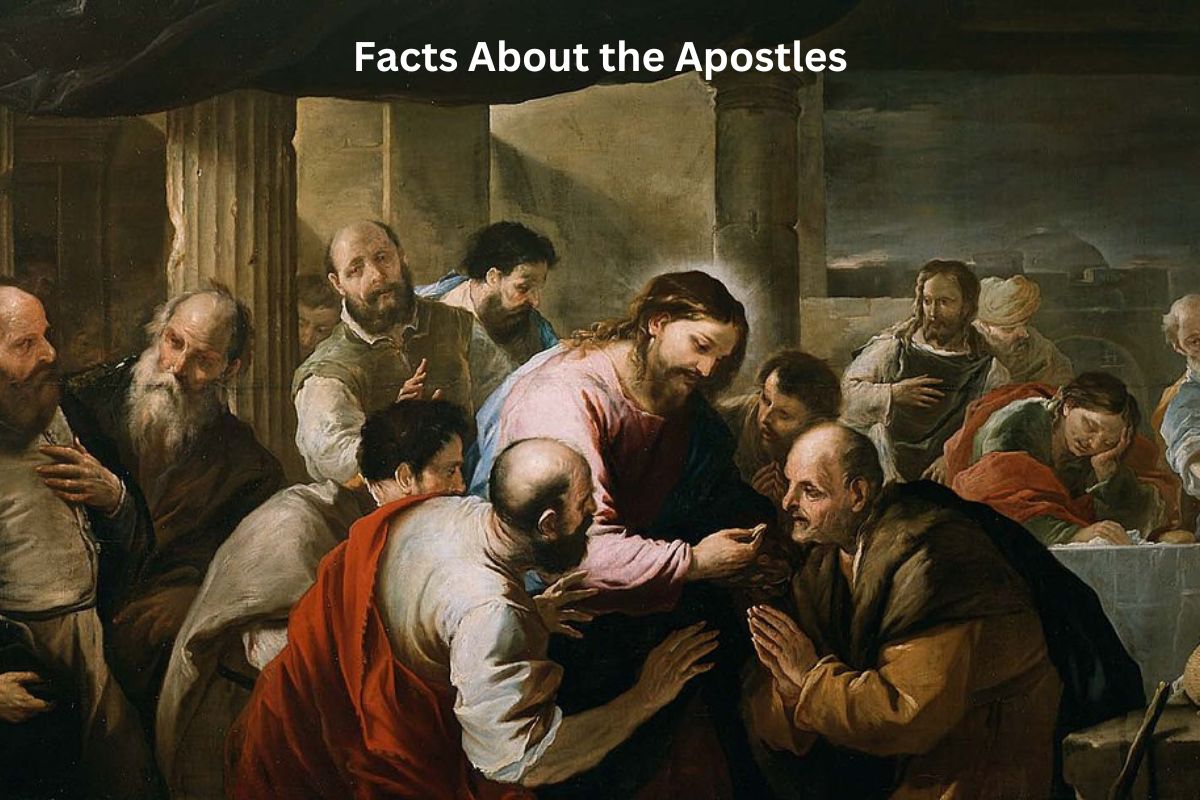The apostles were a group of twelve individuals chosen by Jesus to be his closest companions and to spread his teachings in Christian tradition. They played a pivotal role in the early Christian movement and are central figures in the New Testament.
Each apostle had unique qualities and contributions, and their stories include significant events such as Judas Iscariot’s betrayal, the replacement of Judas with Matthias, and the leadership of figures like Peter.
Some apostles, such as John, Thomas, and Andrew, are known for their distinct roles and experiences. Additionally, many apostles faced martyrdom for their faith, underscoring their dedication to the message of Jesus Christ.
The Apostles Facts
1. The Twelve Apostles
The Twelve Apostles, also known as the Twelve Disciples, were a group of individuals chosen by Jesus to be his closest followers and to spread his teachings. They played a crucial role in the early Christian movement, laying the foundation for Christianity as we know it today.
The Twelve Apostles:
- Peter
- James (son of Zebedee)
- John
- Andrew
- Philip
- Bartholomew (Nathanael)
- Matthew
- Thomas
- James (son of Alphaeus)
- Thaddaeus (Lebbaeus)
- Simon the Zealot
- Judas Iscariot (later replaced by Matthias)
Each of the Twelve Apostles had a unique role and personality within the group, and they were entrusted with carrying forward Jesus’ message of love, redemption, and salvation.

2. Judas Iscariot’s Betrayal:
Judas Iscariot is perhaps the most infamous among the apostles. He was one of the original Twelve Apostles chosen by Jesus but is best known for his act of betrayal.
According to the New Testament accounts (Matthew 26:14-16, Mark 14:10-11, Luke 22:3-6), Judas agreed to betray Jesus to the religious authorities for thirty pieces of silver. He led them to Jesus in the Garden of Gethsemane, where Jesus was arrested, setting in motion the events that would ultimately lead to Jesus’ crucifixion.
Also Read: The Apostle John Facts
Judas’ actions have been a subject of fascination and moral contemplation for centuries, symbolizing the archetype of betrayal. His remorse and eventual suicide are also recorded in the Bible (Matthew 27:3-5).
3. Replacement for Judas:
After Judas Iscariot’s betrayal and subsequent death, the remaining eleven apostles felt the need to fill the vacancy among the Twelve Apostles. This decision is documented in the book of Acts in the New Testament.
In Acts 1:15-26, Peter proposed selecting a replacement for Judas to ensure that there were still twelve apostles. Two candidates, Joseph called Barsabbas (also known as Justus) and Matthias, were put forward. Through prayer and casting lots, Matthias was chosen to fill the role vacated by Judas.
Matthias’ selection demonstrated the apostles’ commitment to maintaining the symbolic number of twelve apostles, which held significance in early Christian tradition.
4. Peter’s Leadership:
Peter, also known as Simon Peter or Cephas, was one of the most prominent and influential figures among the Twelve Apostles. He is often regarded as the leader of the apostles by early Christians.
Also Read: Apostle Paul Timeline
Peter’s leadership role is highlighted in the New Testament, particularly in the Gospels and the book of Acts. He was one of the first disciples called by Jesus and became a central figure in many important events in Jesus’ ministry.
According to tradition, Peter was the rock upon which Jesus would build his church (Matthew 16:18). He is also associated with the keys to the kingdom of heaven, symbolizing his authority within the early Christian community.
Peter’s leadership extended to the post-resurrection period, where he played a pivotal role in the early Christian church, including preaching on the day of Pentecost and participating in important decisions within the apostolic community.

5. John the Beloved:
John, the son of Zebedee, is often referred to as the “beloved disciple” or the “disciple whom Jesus loved.” This designation suggests a close and special relationship between John and Jesus.
John is traditionally believed to be the author of several significant biblical texts, including the Gospel of John, which is known for its unique theological perspective and portrayal of Jesus’ divinity.
In addition to the Gospel, John is attributed to writing three Epistles (1 John, 2 John, and 3 John) and the Book of Revelation, which is a highly symbolic and apocalyptic work describing visions of the end times.
6. Thomas the Doubter:
Thomas, also known as “Doubting Thomas,” is famous for his initial skepticism regarding Jesus’ resurrection. When the other apostles told him that they had seen the risen Jesus, Thomas expressed doubt and famously declared that he would only believe if he could see and touch the wounds of Jesus.
However, when Jesus later appeared to Thomas and invited him to touch his wounds, Thomas immediately believed and exclaimed, “My Lord and my God!” (John 20:28). This event emphasizes the importance of faith and belief in Jesus’ divinity.
Thomas’ story serves as a reminder that doubt and questions can be a natural part of one’s faith journey and that encountering Jesus personally can lead to profound belief and transformation.
7. Andrew’s Crucifixion:
Andrew was one of the Twelve Apostles and the brother of Peter. He is known for his role in bringing people to Jesus, including introducing Peter to Jesus.
According to tradition, Andrew was crucified on an X-shaped cross, which is now known as the St. Andrew’s Cross. This method of crucifixion is also called the saltire cross.
Andrew is considered the patron saint of Scotland, and the St. Andrew’s Cross, or the Saltire, is featured on the Scottish flag.

8. Philip and Bartholomew:
Philip and Bartholomew (also known as Nathanael) were two of the Twelve Apostles.
Philip is mentioned in the Gospels as the apostle who brought Nathanael to Jesus. When Philip told Nathanael that they had found the Messiah, Nathanael initially expressed skepticism but later became a follower of Jesus.
Bartholomew is sometimes identified with Nathanael, as some biblical scholars believe they are the same person. Regardless of this identification, Bartholomew is listed among the apostles and played a role in spreading Jesus’ teachings.
9. James the Greater and James the Lesser:
Two of the apostles were named James, leading to a distinction between James the Greater and James the Lesser to differentiate them.
James the Greater, the son of Zebedee, was one of the inner circle of apostles along with Peter and John. He was present at significant events in Jesus’ life, such as the Transfiguration and the raising of Jairus’ daughter. James the Greater was martyred by King Herod Agrippa I, making him one of the first apostles to be martyred.
James the Lesser, also known as James, son of Alphaeus, is mentioned in the lists of the Twelve Apostles but is less prominently featured in the New Testament. He may have had a quieter role in the early Christian community.
10. Thaddaeus or Lebbaeus:
Thaddaeus is sometimes referred to as Lebbaeus and is listed among the apostles in the Gospels.
Not much is known about Thaddaeus from the biblical accounts, as he is not featured prominently in the New Testament.
Thaddaeus is sometimes associated with Jude (not to be confused with Judas Iscariot), and he is traditionally considered the author of the Epistle of Jude in the New Testament.
11. Simon the Zealot:
Simon the Zealot, also known as Simon the Canaanite, was one of the Twelve Apostles.
The term “Zealot” may suggest that Simon had some association with the Zealots, a Jewish nationalist and revolutionary group that opposed Roman rule. However, the New Testament does not provide specific details about his involvement with the Zealots.
Simon is mentioned in the lists of the apostles but is not featured prominently in the Gospels. Consequently, not much is known about his specific contributions or actions within the early Christian community.

12. Apostle Paul
Paul was not one of the original Twelve Apostles chosen by Jesus during his earthly ministry. Instead, he had initially been a zealous persecutor of Christians, but his life took a dramatic turn when he experienced a profound encounter with the risen Jesus on the road to Damascus (Acts 9:1-19).
Following his conversion, Paul became a fervent Christian and played a crucial role in the early Christian church. He is often referred to as the “Apostle to the Gentiles” because of his primary mission to preach the Gospel to non-Jewish populations, expanding the reach of Christianity beyond its Jewish origins.
Paul embarked on several missionary journeys, traveling extensively throughout the eastern Mediterranean region to establish Christian communities and churches. His travels and teachings are documented in the book of Acts and his various letters, or Epistles, in the New Testament.
His Epistles, including Romans, Corinthians, Galatians, Ephesians, Philippians, Colossians, Thessalonians, Timothy, Titus, and Philemon, form a significant portion of the New Testament. These letters contain theological teachings, moral guidance, and instructions for early Christian communities.
Paul’s theology emphasized salvation by grace through faith in Jesus Christ and the inclusion of Gentiles in the Christian faith without the need to follow Jewish laws and customs.
His writings and missionary efforts profoundly influenced the development of Christian theology and doctrine, shaping many core beliefs of the Christian faith, such as the nature of salvation, the role of faith, and the relationship between Jews and Gentiles in the Church.
Although Paul faced significant challenges, including imprisonment and persecution for his faith, his dedication to spreading the Gospel contributed significantly to the growth of Christianity in the first century and its enduring impact on subsequent generations of believers.
13. Martyrdom
According to tradition and various historical accounts, most of the apostles faced martyrdom for their faith in Jesus Christ.
Some of the apostles’ martyrdoms are documented in early Christian writings and traditions, but the details can vary. For example:
- Peter is traditionally believed to have been crucified upside down in Rome.
- Andrew was crucified on an X-shaped cross, also known as the St. Andrew’s Cross.
- James the Greater was beheaded by King Herod Agrippa I (as recorded in Acts 12:2).
- Thomas is said to have been martyred with a spear in India.
- Philip, Bartholomew, and others are also believed to have been martyred for their faith.
These apostolic martyrdoms are often seen as a testament to their unwavering commitment to spreading the message of Jesus, even in the face of persecution and death.
It’s important to note that the historical accuracy of some of these accounts is a subject of debate among scholars, but they have played a significant role in Christian tradition.
